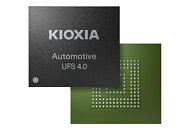- Joined
- Oct 9, 2007
- Messages
- 47,577 (7.46/day)
- Location
- Dublin, Ireland
| System Name | RBMK-1000 |
|---|---|
| Processor | AMD Ryzen 7 5700G |
| Motherboard | ASUS ROG Strix B450-E Gaming |
| Cooling | DeepCool Gammax L240 V2 |
| Memory | 2x 8GB G.Skill Sniper X |
| Video Card(s) | Palit GeForce RTX 2080 SUPER GameRock |
| Storage | Western Digital Black NVMe 512GB |
| Display(s) | BenQ 1440p 60 Hz 27-inch |
| Case | Corsair Carbide 100R |
| Audio Device(s) | ASUS SupremeFX S1220A |
| Power Supply | Cooler Master MWE Gold 650W |
| Mouse | ASUS ROG Strix Impact |
| Keyboard | Gamdias Hermes E2 |
| Software | Windows 11 Pro |
Kioxia Corporation, a world leader in memory solutions, today announced sampling of the industry's first Universal Flash Storage (UFS) Ver. 4.0 embedded flash memory devices designed for automotive applications. These new, higher performing devices deliver fast embedded storage transfer speeds in a small package size and are targeted to a variety of next-generation automotive applications, including telematics, infotainment systems and ADAS. The improved performance] of UFS products from Kioxia - including approximately +100% for sequential read speed and approximately +40% for sequential write speed - enables these applications to take advantage of 5G's connectivity benefits, leading to faster system startup times and a better user experience.
The first to introduce UFS technology, Kioxia continues to move the technology forward. Its new UFS Ver. 4.0 devices integrate the company's innovative BiCS FLASH 3D flash memory and a controller in a JEDEC-standard package. UFS 4.0 incorporates MIPI M-PHY 5.0 and UniPro 2.0 and supports theoretical interface speeds of up to 23.2 Gbps per lane or 46.4 Gbps per device. UFS 4.0 is backward compatible with UFS 3.1.

The new Kioxia devices support High Speed Link Startup Sequence (HS-LSS) features, enabling Link Startup (M-PHY and UniPro initialization sequence) between device and host to be performed at a faster HS-G1 Rate A (1248 megabits per second) than that of conventional UFS. This is expected to reduce the time for Link Startup by approximately 70% compared to the conventional method.
Advanced features and functionalities are supported in the new UFS Ver. 4.0 devices to address demanding automotive application requirements, including:
View at TechPowerUp Main Site
The first to introduce UFS technology, Kioxia continues to move the technology forward. Its new UFS Ver. 4.0 devices integrate the company's innovative BiCS FLASH 3D flash memory and a controller in a JEDEC-standard package. UFS 4.0 incorporates MIPI M-PHY 5.0 and UniPro 2.0 and supports theoretical interface speeds of up to 23.2 Gbps per lane or 46.4 Gbps per device. UFS 4.0 is backward compatible with UFS 3.1.

The new Kioxia devices support High Speed Link Startup Sequence (HS-LSS) features, enabling Link Startup (M-PHY and UniPro initialization sequence) between device and host to be performed at a faster HS-G1 Rate A (1248 megabits per second) than that of conventional UFS. This is expected to reduce the time for Link Startup by approximately 70% compared to the conventional method.
Advanced features and functionalities are supported in the new UFS Ver. 4.0 devices to address demanding automotive application requirements, including:
- Refresh Feature: Improves data reliability by refreshing degraded data to prevent data corruption even in the harsh, demanding in-vehicle environment.
- Extended Diagnosis Feature: Enables users to view important information from the UFS device, allowing preventative action to be taken.
- Available in capacities of 128, 256 and 512 gigabytes (GB), the new Kioxia devices support a wide temperature range, meet AEC-Q100 Grade 2 requirements and offer enhanced reliability capabilities that complex automotive applications require.
View at TechPowerUp Main Site

